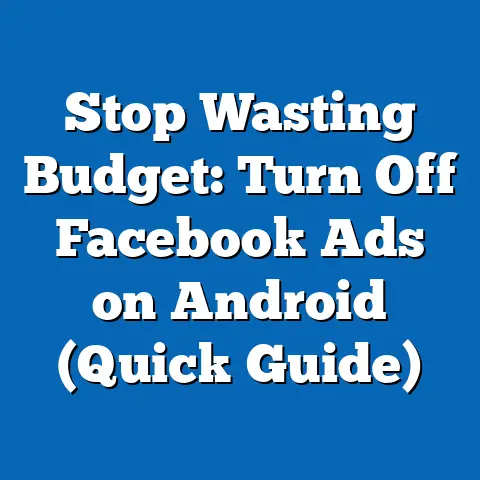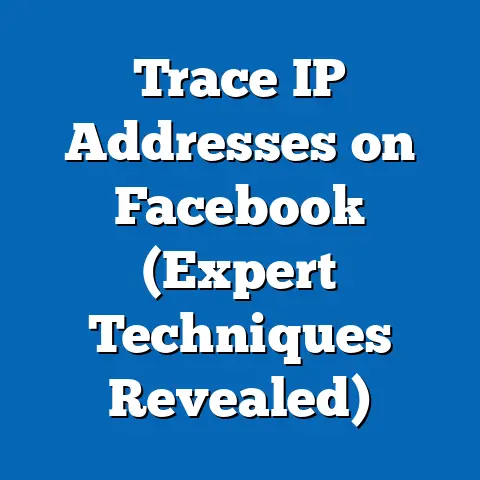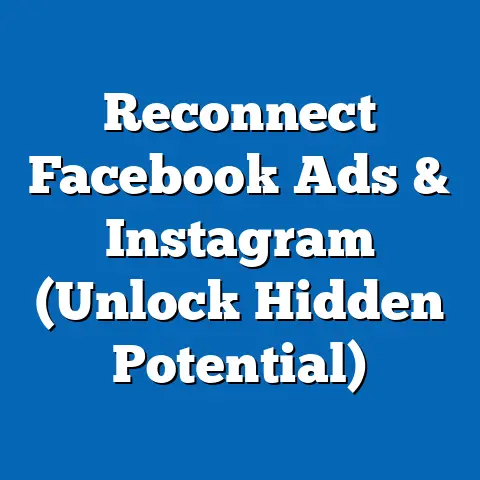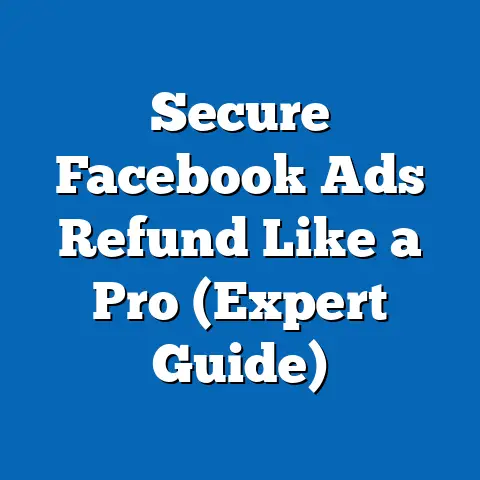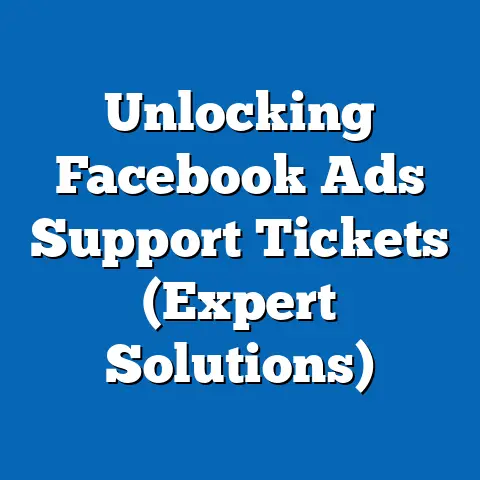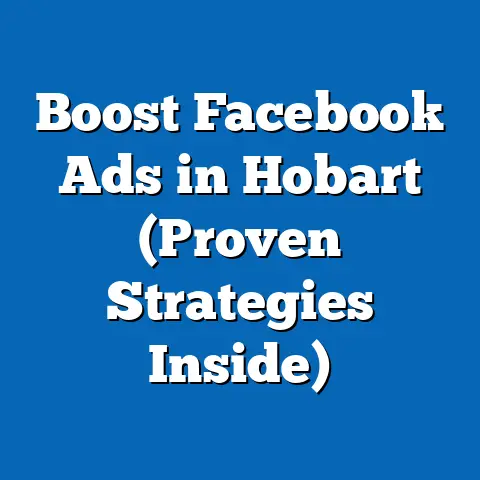Eliminate Facebook Sponsored Ads (Expert Strategies Revealed)
I remember the first time I ran a Facebook ad campaign. I was so excited, picturing hordes of new customers flocking to my (then fledgling) online store. I poured my heart into crafting what I thought was the perfect ad. I painstakingly chose the image, wrote compelling copy (or so I thought), and carefully selected my target audience.
The launch day arrived, and… crickets. A few likes, a handful of clicks, and zero sales. I was devastated, and more importantly, I was out a decent chunk of my marketing budget. It felt like throwing money into a black hole.
That experience, painful as it was, sparked a deep dive into the world of Facebook advertising. I realized that simply throwing money at sponsored ads wasn’t enough. Success required strategy, data analysis, and a willingness to constantly adapt and optimize.
That’s where the concept of layering comes in. Layering, in the context of Facebook ads, is about creating multi-faceted campaigns that target different segments of your audience with tailored messages and creative approaches. It’s about understanding that your audience isn’t a monolith, and that one-size-fits-all advertising rarely delivers optimal results.
While Facebook sponsored ads can be powerful tools for reaching audiences, there are expert strategies to eliminate ineffective ad spend and optimize advertising efforts. Let’s dive in.
Section 1: Understanding Facebook Sponsored Ads
Definition and Overview
Facebook sponsored ads are paid advertisements that appear on the Facebook platform, including the news feed, right column, and within Facebook’s Audience Network. These ads allow businesses to target specific demographics, interests, and behaviors, making them a powerful tool for reaching potential customers.
In essence, Facebook advertising is a way to cut through the organic noise and get your message in front of the right people. Instead of relying solely on organic reach (which, let’s be honest, is increasingly limited), sponsored ads allow you to actively target users who are most likely to be interested in your products or services.
The evolution of Facebook advertising has been remarkable. From its humble beginnings as simple text-based ads, the platform has evolved into a sophisticated advertising ecosystem with a wide array of ad formats, targeting options, and optimization tools.
Here are some key statistics that highlight the relevance and effectiveness of Facebook advertising:
- Reach: Facebook boasts over 2.9 billion monthly active users, making it the largest social media platform in the world (Source: Meta Q1 2024 Earnings Report). This massive reach provides unparalleled opportunities for businesses to connect with potential customers.
- Ad Revenue: Facebook generated over $116 billion in ad revenue in 2023 (Source: Meta Q4 2023 Earnings Report). This figure underscores the platform’s dominance in the digital advertising landscape and the value that businesses place on its advertising capabilities.
- Mobile Dominance: Mobile advertising accounts for the vast majority of Facebook’s ad revenue (around 94%). This highlights the importance of optimizing your ads for mobile devices.
- Targeting Power: Facebook’s advanced targeting options allow advertisers to reach highly specific audiences based on demographics, interests, behaviors, and more. This level of granularity enables businesses to create highly relevant and personalized ad experiences.
- ROI: Studies have shown that Facebook advertising can deliver a significant return on investment for businesses across various industries. The exact ROI will vary depending on factors such as industry, target audience, ad creative, and campaign optimization.
For example, imagine a local bakery trying to attract more customers. They could use Facebook ads to target people within a specific radius of their store who have expressed an interest in baking, desserts, or local businesses. They could even target people who have recently engaged with their Facebook page. This level of precision allows the bakery to reach the most relevant audience and maximize the effectiveness of their ad spend.
Common Challenges with Sponsored Ads
Despite the potential benefits, many advertisers struggle to achieve success with Facebook sponsored ads. Common pitfalls include:
- Ad Fatigue: Showing the same ad to the same audience repeatedly can lead to ad fatigue, where users become desensitized to the ad and stop engaging with it. This results in declining performance and wasted ad spend. I’ve seen this happen firsthand when I didn’t refresh my ad creative often enough. My initial engagement was high, but after a few weeks, it plummeted.
- Poor Targeting: Targeting the wrong audience can result in low engagement rates and wasted ad spend. For example, targeting a broad audience with generic interests may not yield the desired results. It’s like casting a wide net hoping to catch something, but ending up with mostly seaweed.
- High Costs Without Adequate Returns: In some cases, advertisers may experience high costs per click (CPC) or cost per acquisition (CPA) without seeing a corresponding increase in sales or leads. This can be due to a variety of factors, including poor ad creative, ineffective targeting, or a lack of optimization. I once worked with a client who was paying a fortune for clicks, but their landing page was a mess. No matter how great the ad was, the user experience was terrible, and conversions were non-existent.
- Lack of Clear Goals: Without clearly defined goals, it’s difficult to measure the success of your ad campaigns and make informed decisions about optimization. Are you trying to drive website traffic, generate leads, or increase sales? Knowing your goals is crucial for selecting the right campaign objectives and tracking the right metrics.
- Ignoring Mobile Optimization: As mentioned earlier, mobile devices account for the vast majority of Facebook’s ad revenue. Failing to optimize your ads for mobile can result in a poor user experience and lower engagement rates. Ensure your ad creative is mobile-friendly and that your landing pages are optimized for mobile devices.
Real-world Example:
I remember a local restaurant owner who came to me frustrated with his Facebook ad campaigns. He was running a single ad targeting everyone within a 10-mile radius, promoting a generic “dinner special.” He was spending a significant amount of money, but seeing very little return. After analyzing his campaign, I realized that his targeting was too broad, his ad creative was uninspired, and he wasn’t tracking any meaningful metrics.
We revamped his campaign by segmenting his audience based on interests (e.g., Italian food, seafood, vegetarian), creating targeted ad creative for each segment, and tracking key metrics like website visits and online reservations. The results were dramatic. His ad spend remained the same, but his online reservations increased by over 50%.
Key Takeaway:
Understanding the challenges of Facebook advertising is the first step towards overcoming them. By being aware of the common pitfalls and taking steps to avoid them, you can significantly improve the performance of your ad campaigns and maximize your return on investment.
Next Steps:
- Reflect on your past Facebook ad campaigns. What challenges did you face?
- Identify areas where you can improve your targeting, ad creative, or tracking.
- Start thinking about how you can implement layering strategies to create more effective campaigns.
Section 2: The Importance of Data Analysis in Eliminating Ineffective Ads
Data analysis is the cornerstone of successful Facebook advertising. Without it, you’re essentially flying blind, making decisions based on gut feeling rather than evidence. You need to understand what’s working, what’s not, and why. This involves leveraging the powerful analytics tools available within Facebook and using that data to make informed decisions about your campaigns.
Leveraging Facebook Insights
Facebook Insights and Ads Manager are your primary tools for analyzing ad performance. They provide a wealth of data on your audience, ad engagement, and campaign results.
- Facebook Insights (for your Page): This tool provides insights into your audience demographics, interests, and behaviors. It also shows you how people are interacting with your Page content.
- Ads Manager: This is where you manage your ad campaigns and track their performance. It provides detailed data on impressions, reach, clicks, conversions, and more.
Key Metrics to Focus On:
- Reach: The number of unique people who saw your ad. A high reach indicates that your ad is being seen by a large audience. However, reach alone doesn’t guarantee success.
- Impressions: The number of times your ad was displayed. Impressions can be higher than reach if the same person sees your ad multiple times.
- Click-Through Rate (CTR): The percentage of people who saw your ad and clicked on it. A high CTR indicates that your ad is relevant and engaging. I generally aim for a CTR of at least 1% for most campaigns. Anything lower than that, and I start digging into the ad creative and targeting.
- Cost Per Click (CPC): The average cost you pay each time someone clicks on your ad. A low CPC indicates that your ad is efficient and cost-effective. CPCs can vary widely depending on your industry, target audience, and ad quality.
- Conversion Rate: The percentage of people who clicked on your ad and completed a desired action (e.g., making a purchase, filling out a form, signing up for a newsletter). A high conversion rate indicates that your ad is effectively driving results.
- Cost Per Acquisition (CPA): The average cost you pay to acquire a new customer or lead. A low CPA indicates that your ad is cost-effective for acquiring new customers.
- Return on Ad Spend (ROAS): The amount of revenue you generate for every dollar you spend on advertising. A high ROAS indicates that your ad is generating a significant return on investment. This is arguably the most important metric to track, as it directly measures the profitability of your ad campaigns. I always tell my clients to focus on maximizing ROAS.
How to Use Facebook Insights and Ads Manager:
- Access Facebook Insights: Go to your Facebook Page and click on the “Insights” tab.
- Explore the Data: Explore the various sections of Facebook Insights to learn about your audience demographics, interests, and behaviors.
- Access Ads Manager: Go to facebook.com/adsmanager.
- Select Your Campaign: Select the campaign you want to analyze.
- Customize Your Columns: Customize the columns in Ads Manager to display the metrics that are most important to you (e.g., Reach, Impressions, CTR, CPC, Conversion Rate, ROAS).
- Analyze the Data: Analyze the data to identify trends and patterns in your ad performance.
- Create Reports: Create reports to track your ad performance over time and identify areas for improvement.
Identifying Underperforming Ads
Recognizing ads that are not delivering expected results is crucial for eliminating wasted ad spend.
Here are some strategies for identifying underperforming ads:
- Set Benchmarks: Establish clear benchmarks for key metrics like CTR, CPC, and ROAS. If an ad is consistently falling below these benchmarks, it’s a sign that it’s underperforming.
- Compare Performance: Compare the performance of different ads within the same campaign. Identify ads that are significantly underperforming compared to others.
- Analyze Trends: Look for trends in your ad performance over time. Is an ad’s performance declining? Is it experiencing ad fatigue?
- Segment Your Data: Segment your data by demographics, interests, and placements to identify specific areas where your ads are underperforming. For example, you might find that your ads are performing well among women aged 25-34, but poorly among men aged 18-24.
- A/B Testing: A/B testing involves creating two or more versions of an ad with slight variations (e.g., different headlines, images, or calls to action) and running them simultaneously to see which performs better. A/B testing can reveal valuable insights into what resonates with your audience. I A/B test everything – headlines, images, ad copy, calls to action. You’d be surprised how a simple change can dramatically impact performance.
Example:
Let’s say you’re running a campaign to promote a new product. You have three different ads in the campaign, each with a different headline. After a week, you analyze the data and find that Ad A has a CTR of 2%, Ad B has a CTR of 1%, and Ad C has a CTR of 0.5%. Based on this data, you can conclude that Ad C is underperforming and should be paused or replaced.
Key Takeaway:
Data analysis is essential for identifying and eliminating ineffective Facebook ads. By leveraging Facebook Insights and Ads Manager, setting benchmarks, comparing performance, analyzing trends, and conducting A/B testing, you can gain valuable insights into what’s working and what’s not.
Next Steps:
- Familiarize yourself with Facebook Insights and Ads Manager.
- Start tracking key metrics for your ad campaigns.
- Establish benchmarks for your key metrics.
- Implement A/B testing to optimize your ad creative.
Section 3: Expert Strategies to Optimize and Eliminate Ineffective Ads
Once you’ve identified underperforming ads, it’s time to take action. This section explores expert strategies for optimizing your campaigns and eliminating wasted ad spend.
Refining Target Audiences
One of the most common reasons for ineffective Facebook ads is poor targeting. Reaching the wrong audience is like shouting into the void – your message will fall on deaf ears.
Advanced Targeting Options:
Facebook offers a wide range of advanced targeting options to help you reach the right audience. These include:
- Demographic Filters: Target users based on age, gender, education, location, relationship status, and more. This is the foundation of most targeting strategies.
- Interest-Based Targeting: Target users based on their interests, hobbies, and activities. Facebook gathers this data from users’ profiles, pages they like, and content they engage with. This is where you can really hone in on your ideal customer.
- Behavioral Targeting: Target users based on their past behaviors and activities on Facebook and other websites. This includes things like purchase history, travel habits, and device usage.
- Custom Audiences: Create custom audiences based on your existing customer data (e.g., email lists, website visitors, app users). This allows you to target people who have already interacted with your brand.
- Lookalike Audiences: Create lookalike audiences based on your custom audiences. Facebook will identify users who share similar characteristics and behaviors with your existing customers. This is a powerful way to expand your reach and find new potential customers.
Case Studies:
- E-commerce Store: An e-commerce store selling organic baby clothes was struggling to reach its target audience. They were initially targeting a broad audience of parents. After refining their targeting to focus on parents interested in organic products, eco-friendly living, and specific parenting blogs, they saw a significant increase in their conversion rate and a decrease in their cost per acquisition.
- Local Gym: A local gym was running ads targeting everyone within a 5-mile radius. They were getting a lot of impressions, but very few leads. After refining their targeting to focus on people interested in fitness, weight loss, and healthy eating, they saw a significant increase in lead generation.
- Software Company: A software company was using lookalike audiences to find new customers. They created a lookalike audience based on their existing customer base and saw a significant increase in their conversion rate.
Tips for Refining Your Target Audiences:
- Know Your Ideal Customer: Before you start creating your target audience, take the time to define your ideal customer. What are their demographics? What are their interests? What are their behaviors?
- Start Broad, Then Narrow Down: Start with a broad audience and then gradually narrow it down based on your data.
- Test Different Audiences: Test different audiences to see which performs best.
- Use Layered Targeting: Combine multiple targeting options to create highly specific audiences. For example, you could target women aged 25-34 who are interested in fashion and live in New York City. This is where the “layering” concept really comes into play.
- Exclude Irrelevant Audiences: Exclude audiences that are not relevant to your business. For example, if you’re selling high-end products, you might want to exclude users with lower incomes.
- Monitor Your Audience Performance: Monitor your audience performance regularly and make adjustments as needed.
Creative Testing and Iteration
Even with perfect targeting, your ads can still fall flat if your creative isn’t compelling. Ad creative is the visual and textual elements of your ad, including the image or video, headline, ad copy, and call to action.
The Importance of Ad Creative:
- Grabs Attention: Your ad creative is what grabs people’s attention as they scroll through their news feed.
- Communicates Your Message: Your ad creative communicates your message and value proposition.
- Drives Action: Your ad creative drives people to take action, such as clicking on your ad, visiting your website, or making a purchase.
Expert Advice on Creative Testing:
- Test Different Ad Formats: Facebook offers a variety of ad formats, including image ads, video ads, carousel ads, and collection ads. Test different ad formats to see which performs best for your business. Video ads are often more engaging than static image ads, but they can also be more expensive to produce.
- Test Different Visuals: Test different images and videos to see which resonates best with your audience. Use high-quality visuals that are relevant to your product or service.
- Test Different Headlines: Test different headlines to see which grabs people’s attention and encourages them to click on your ad. Use clear, concise, and compelling headlines that highlight the benefits of your product or service.
- Test Different Ad Copy: Test different ad copy to see which effectively communicates your message and drives conversions. Use persuasive language that highlights the benefits of your product or service.
- Test Different Calls to Action: Test different calls to action to see which encourages people to take the desired action. Use clear and concise calls to action that tell people exactly what you want them to do (e.g., “Shop Now,” “Learn More,” “Sign Up”).
- Use A/B Testing: Use A/B testing to test different variations of your ad creative. Create two or more versions of your ad with slight variations and run them simultaneously to see which performs better.
- Iterate Based on Data: Continuously iterate on your ad creative based on the data you collect. Analyze your ad performance and make adjustments as needed.
Example:
I worked with a clothing retailer who was running ads featuring product photos on a white background. The ads were generating some clicks, but the conversion rate was low. We decided to test a different approach by using lifestyle photos of people wearing the clothes in real-world settings. The results were dramatic. The lifestyle photos generated significantly more clicks and conversions.
Key Takeaway:
Creative testing and iteration are essential for optimizing your Facebook ads. By testing different ad formats, visuals, headlines, ad copy, and calls to action, you can identify what resonates best with your audience and improve your ad performance.
Next Steps:
- Brainstorm different ideas for your ad creative.
- Create multiple versions of your ad with slight variations.
- Use A/B testing to test different variations of your ad creative.
- Analyze your ad performance and make adjustments as needed.
Budget Management Techniques
Even with perfect targeting and compelling creative, you can still waste money if you don’t manage your budget effectively.
Effective Budget Allocation:
- Set a Realistic Budget: Determine how much you can afford to spend on Facebook advertising. Don’t overspend and put your business at risk.
- Allocate Your Budget Wisely: Allocate your budget across different campaigns and ad sets based on their potential return on investment.
- Use Daily Budgets vs. Lifetime Budgets: Daily budgets allow you to spend a fixed amount each day, while lifetime budgets allow you to spend a fixed amount over the entire duration of your campaign. Daily budgets are generally better for campaigns that run continuously, while lifetime budgets are better for campaigns that have a specific end date.
- Adjust Your Budget Based on Performance: Monitor your ad performance regularly and adjust your budget as needed. If a campaign is performing well, you might want to increase the budget. If a campaign is underperforming, you might want to decrease the budget or pause the campaign altogether.
Example:
Let’s say you have a budget of $1000 per month for Facebook advertising. You’re running two campaigns: one to generate leads and one to drive sales. Based on your initial analysis, you believe that the lead generation campaign has a higher potential return on investment. You might allocate $600 to the lead generation campaign and $400 to the sales campaign.
Tips for Optimizing Your Budget:
- Use Automated Bidding: Facebook offers automated bidding options that can help you optimize your budget and maximize your results. These options include cost per result goal, lowest cost, and value optimization.
- Monitor Your Key Metrics: Monitor your key metrics regularly and make adjustments to your budget as needed.
- Pause Underperforming Ads: Pause ads that are underperforming to avoid wasting money.
- Use Budget Pacing: Budget pacing helps you control how quickly your budget is spent. You can choose to spend your budget evenly throughout the day or to spend it more aggressively during peak hours.
Key Takeaway:
Effective budget management is crucial for maximizing your return on investment. By setting a realistic budget, allocating your budget wisely, adjusting your budget based on performance, and using automated bidding, you can optimize your ad spend and achieve your advertising goals.
Next Steps:
- Determine your budget for Facebook advertising.
- Allocate your budget across different campaigns and ad sets.
- Use daily budgets vs. lifetime budgets based on your campaign goals.
- Monitor your ad performance and adjust your budget as needed.
Section 4: Layering Strategies for Comprehensive Campaigns
Now that we’ve covered the fundamentals of Facebook advertising and expert strategies for optimizing your campaigns, let’s dive into the heart of this article: layering strategies.
Layering, as I mentioned earlier, involves creating multi-faceted campaigns that target different segments of your audience with tailored messages and creative approaches. It’s about understanding that your audience isn’t a monolith and that one-size-fits-all advertising rarely delivers optimal results.
Building a Layered Campaign Structure
A layered campaign structure typically involves multiple ad sets targeting various audience segments. Each ad set should have its own unique targeting parameters, ad creative, and budget.
Example:
Let’s say you’re selling a fitness app. You could create a layered campaign structure with the following ad sets:
- Ad Set 1: Beginners: Target people who are new to fitness and interested in weight loss, healthy eating, and beginner workouts.
- Ad Set 2: Intermediate: Target people who are already active and interested in strength training, endurance training, and advanced workouts.
- Ad Set 3: Retargeting: Target people who have visited your website or downloaded your app but haven’t yet subscribed to a premium plan.
Each ad set would have its own unique ad creative tailored to the specific audience segment. For example, the ad creative for the “Beginners” ad set might focus on the ease of use of the app and the benefits of getting started with fitness. The ad creative for the “Intermediate” ad set might focus on the advanced features of the app and the benefits of taking their fitness to the next level. The retargeting ad set might offer a special discount or promotion to encourage users to subscribe to a premium plan.
The Role of Retargeting Ads:
Retargeting ads play a crucial role in a layered strategy. They allow you to re-engage users who have previously interacted with your brand but haven’t yet converted.
Types of Retargeting Audiences:
- Website Visitors: Target people who have visited your website.
- App Users: Target people who have downloaded your app.
- Email Subscribers: Target people who are subscribed to your email list.
- Facebook Page Engagers: Target people who have engaged with your Facebook page (e.g., liked, commented, or shared your posts).
- Video Viewers: Target people who have watched your videos on Facebook.
Example:
Let’s say someone visits your website and views a specific product page but doesn’t add the product to their cart. You could retarget them with an ad featuring that specific product, highlighting its key features and benefits. You could even offer a special discount to encourage them to complete the purchase.
Key Takeaway:
Building a layered campaign structure allows you to reach different segments of your audience with tailored messages and creative approaches. Retargeting ads play a crucial role in re-engaging users who have previously interacted with your brand but haven’t yet converted.
Next Steps:
- Identify different segments of your audience.
- Create ad sets targeting each segment.
- Develop ad creative tailored to each segment.
- Implement retargeting ads to re-engage users who have previously interacted with your brand.
Integrating Multiple Channels
Layering isn’t just about Facebook ads. It’s about integrating your Facebook ad campaigns with other marketing channels for a holistic approach.
Example:
Let’s say you’re running a Facebook ad campaign to generate leads. You could integrate it with your email marketing efforts by automatically adding the leads you generate on Facebook to your email list. You could then send them a series of emails nurturing them and encouraging them to become customers.
Integrating Facebook Ads with Other Marketing Channels:
- Instagram: Facebook and Instagram are closely integrated. You can run your Facebook ads on Instagram as well. This allows you to reach a wider audience and leverage the visual power of Instagram.
- Email Marketing: Integrate your Facebook ad campaigns with your email marketing efforts. Collect email addresses through your Facebook ads and use email marketing to nurture leads and drive sales.
- SEO: Optimize your website for search engines to attract organic traffic. Integrate your Facebook ad campaigns with your SEO efforts by driving traffic to your website.
- Content Marketing: Create valuable content that attracts and engages your target audience. Promote your content through your Facebook ads and drive traffic to your website.
- Influencer Marketing: Partner with influencers to promote your brand and products on Facebook.
Successful Multi-Channel Campaigns:
- Subscription Box Company: A subscription box company ran a Facebook ad campaign targeting people interested in beauty products. They integrated their Facebook ads with their email marketing efforts by offering a free sample box to people who signed up for their email list through the Facebook ad. They then sent them a series of emails promoting their subscription box and highlighting its benefits.
- Online Course Provider: An online course provider ran a Facebook ad campaign targeting people interested in learning new skills. They integrated their Facebook ads with their content marketing efforts by creating a series of blog posts and videos related to their courses. They then promoted their content through their Facebook ads and drove traffic to their website.
Key Takeaway:
Integrating your Facebook ad campaigns with other marketing channels allows you to reach a wider audience, nurture leads, and drive sales. A holistic approach is key to maximizing your marketing ROI.
Next Steps:
- Identify opportunities to integrate your Facebook ad campaigns with other marketing channels.
- Develop a multi-channel marketing strategy.
- Track your results and make adjustments as needed.
Section 5: Tools and Resources for Campaign Optimization
Optimizing your Facebook ad campaigns can be time-consuming and complex. Fortunately, there are a variety of tools and resources available to help you streamline the process and maximize your results.
Recommended Tools for Analysis and Management
- Facebook Ads Manager: This is Facebook’s own ad management platform. It provides a comprehensive suite of tools for creating, managing, and analyzing your ad campaigns. It’s essential to become proficient in using Ads Manager.
- Facebook Business Suite: This platform allows you to manage your Facebook Page, Instagram account, and messaging all in one place. It also provides insights into your audience and content performance.
- Hootsuite: Hootsuite is a social media management platform that allows you to schedule posts, monitor your social media activity, and analyze your results. It can be used to manage your Facebook Page and Instagram account.
- Sprout Social: Sprout Social is another social media management platform that offers similar features to Hootsuite. It also provides advanced analytics and reporting capabilities.
- AdEspresso: AdEspresso is a Facebook ad optimization tool that helps you create, test, and optimize your ad campaigns. It provides a variety of features, including A/B testing, budget optimization, and audience insights. I’ve found AdEspresso particularly useful for quickly testing multiple ad variations.
- SEMrush: SEMrush is a comprehensive digital marketing platform that provides tools for SEO, PPC, social media marketing, and content marketing. It can be used to analyze your competitors’ Facebook ad campaigns and identify opportunities for improvement.
Benefits of Using These Tools:
- Streamlined Ad Management: These tools can help you streamline the ad management process, saving you time and effort.
- Improved Ad Performance: These tools can help you improve your ad performance by providing insights into your audience, ad creative, and budget.
- Data-Driven Decision Making: These tools can help you make data-driven decisions about your ad campaigns, leading to better results.
Staying Updated with Facebook Algorithm Changes
Facebook’s algorithm is constantly evolving. What worked yesterday might not work today. It’s crucial to stay updated with the latest changes to the algorithm and adapt your strategies accordingly.
How Algorithm Changes Impact Ad Performance:
- Reach and Impressions: Algorithm changes can impact the reach and impressions of your ads.
- Engagement: Algorithm changes can impact the engagement rates of your ads (e.g., likes, comments, shares).
- Relevance Score: Facebook uses a relevance score to determine how relevant your ads are to your target audience. Algorithm changes can impact your relevance score.
- Ad Costs: Algorithm changes can impact the cost of your ads.
Strategies to Adapt:
- Stay Informed: Stay informed about the latest algorithm changes by following industry blogs, attending webinars, and reading Facebook’s official resources.
- Monitor Your Ad Performance: Monitor your ad performance regularly and identify any changes or trends.
- Adjust Your Strategies: Adjust your strategies as needed to adapt to the latest algorithm changes.
- Test and Iterate: Continuously test and iterate on your ad creative, targeting, and bidding strategies.
- Focus on High-Quality Content: Create high-quality content that is relevant and engaging to your target audience.
Resources for Staying Updated:
- Facebook Business Help Center: This is Facebook’s official resource for information about Facebook advertising.
- Facebook Marketing Partners: These are third-party companies that have been vetted by Facebook and offer a variety of services related to Facebook advertising.
- Industry Blogs: Follow industry blogs like Social Media Examiner, MarketingProfs, and HubSpot to stay updated with the latest trends and best practices in Facebook advertising.
- Webinars: Attend webinars hosted by industry experts to learn about the latest algorithm changes and how to adapt your strategies.
Key Takeaway:
Staying updated with Facebook algorithm changes is crucial for maintaining the effectiveness of your ad campaigns. By staying informed, monitoring your ad performance, adjusting your strategies, and focusing on high-quality content, you can adapt to the ever-changing landscape of Facebook advertising.
Next Steps:
- Follow industry blogs and attend webinars to stay updated with the latest trends and best practices in Facebook advertising.
- Monitor your ad performance regularly and identify any changes or trends.
- Adjust your strategies as needed to adapt to the latest algorithm changes.
Conclusion: The Future of Facebook Advertising
The landscape of Facebook advertising is constantly evolving. New ad formats are introduced, targeting options are refined, and the algorithm is continuously updated. This dynamic environment requires advertisers to be adaptable, data-driven, and always willing to learn.
The concept of layering, as we’ve discussed throughout this article, is more relevant than ever. By understanding the nuances of your audience, crafting tailored messages, and integrating your Facebook ad campaigns with other marketing channels, you can create comprehensive and effective advertising strategies.
The future of Facebook advertising will likely be driven by:
- Artificial Intelligence (AI): AI will play an increasingly important role in Facebook advertising, helping advertisers automate tasks, optimize their campaigns, and personalize ad experiences.
- Augmented Reality (AR): AR will offer new and innovative ways for advertisers to engage with their audience.
- Personalization: Personalization will become even more important as advertisers strive to deliver highly relevant and engaging ad experiences.
- Privacy: Privacy will continue to be a major concern for Facebook and its users. Advertisers will need to be transparent about how they collect and use data.
Final Thoughts:
By employing expert strategies, focusing on data-driven decision-making, and staying adaptable to the ever-changing landscape of Facebook advertising, you can eliminate ineffective sponsored ads and drive meaningful engagement with your audience.
Call to Action: Engage with the Community
I encourage you to share your experiences with Facebook sponsored ads and the strategies that have worked for you. What challenges have you faced? What successes have you achieved? What are your favorite tools and resources for campaign optimization?
Please feel free to comment on this article and share your insights. Let’s foster a community of learning and sharing, where we can all learn from each other’s experiences and improve our Facebook advertising skills.
You can also connect with me on social media to continue the conversation. I’m always happy to share my knowledge and help others succeed with Facebook advertising.
Thank you for reading! I hope this article has been helpful and informative. Now go out there and start eliminating those ineffective Facebook sponsored ads!

